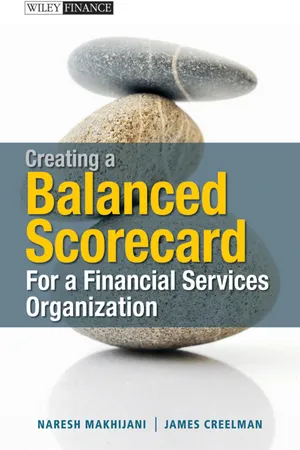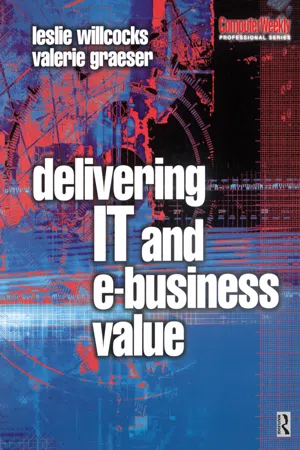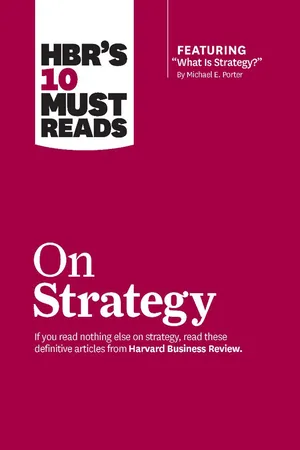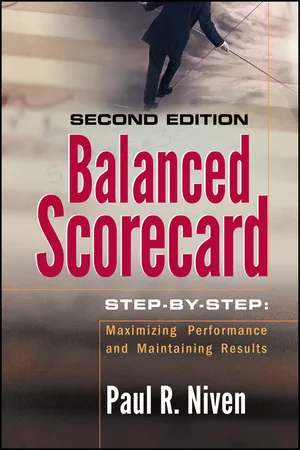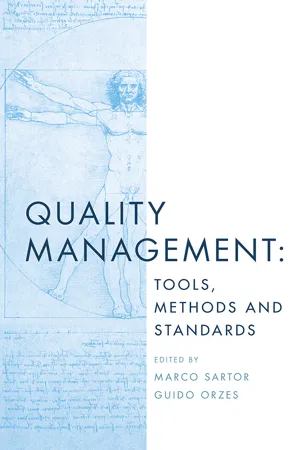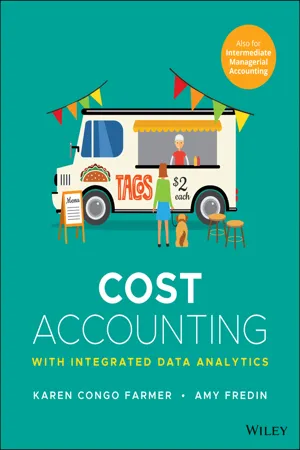Technology & Engineering
Balanced Scorecard
The Balanced Scorecard is a strategic management tool that helps organizations monitor and manage performance across multiple perspectives, such as financial, customer, internal processes, and learning and growth. It provides a framework for setting objectives, measuring progress, and aligning strategic initiatives to ensure the organization's long-term success.
Written by Perlego with AI-assistance
Related key terms
1 of 5
12 Key excerpts on "Balanced Scorecard"
- James Creelman, Naresh Makhijani(Authors)
- 2011(Publication Date)
- Wiley(Publisher)
As part of this review, Kaplan and Norton received a presentation from Analog Devices. The company's then vice-president of quality improvement and productivity, Art Schneiderman, explained to the study group how Analog Devices was successfully using what it called “a corporate scorecard” to monitor its performance. This scorecard included performance measures relating to customer delivery times, quality, and cycle times for manufacturing processes, and effectiveness of new product development, as well as financial measures.The study group considered Analog's approach a promising start for a new balanced measurement system, and adopted the term scorecard. Consequently, on the basis of this research program, Kaplan and Norton formulated the first-generation Balanced Scorecard.A Balanced Measurement SystemPositioned at this stage as a measurement system, the classic Balanced Scorecard set out to capture performance from four perspectives: one financial and three nonfinancial: customer, internal process, and learning and innovation (subsequently redefined as learning and growth when Kaplan and Norton realized that innovation correctly belonged within the internal process perspective). Figure 2.1 shows a schematic of the Balanced Scorecard, illustrating how it supports a central vision and strategy. Around this hub is built the four perspectives with their own strategic objectives, measures, targets, and initiatives.The Emergence of the Strategy MapFigure 2.1 A schematic of the Balanced ScorecardAlthough organizations gained substantial value from the first-generation Balanced Scorecard, some early adopters, including CIGNA Property & Casualty and Mobil Oil, found that the Balanced Scorecard worked best not when used simply as an extension of the financial measurement system, but when it was hardwired to strategy and deployed as a strategic implementation system.What they found to be missing was a mechanism for showing the cause-and-effect relationship among the strategic objectives from the four perspectives. Thus was born the idea of strategy maps (which would eventually become the topic of Kaplan and Norton's third book).4 Originally, the maps were generally referred to as linkage models. Figure 2.2- eBook - ePub
- Leslie Willcocks, Valerie Graeser(Authors)
- 2013(Publication Date)
- Routledge(Publisher)
In its ultimate implementation, the scorecard concept encompasses the entire organization. The IT function can be effectively included in this panorama. In particular given that the proliferation of technology in the organization is difficult to control, the scorecard approach can help to harness known benefits as well as those that are less tangible.Ultimately, what is required of a measurement program is a set of measures that addresses both external and internal processes and outputs for an organization. More specifically, any new class of performance measures should:– increase the scope of the measurement focus beyond financial reporting to less tangible benefits; – create value through a focus on quality, service and speed; – instigate organizational learning and innovation; and – motivate appropriate long-term behaviour at all levels of the organization. The scorecard concept can address these requirements.5.3 What is a ‘balanced business scorecard’?
A balanced business scorecard is ultimately a translation of a company's strategic objectives into a set of performance measures. As the ultimate source of the measures, the company strategy is the driving force behind the claim that a scorecard assists in focusing the organization on strategic vision. The use of the word ‘balanced’ in the description of the approach implies a set of measurements that spans the significant processes and focuses of an organization. It also implies a balance between short- and long-term focus; between strategic and operational measures; between hard and soft measures; and between identified cause and effect factors. ‘Scorecard’ implies measurement against a goal or target.In the words of Kaplan and Norton: ‘the Balanced Scorecard provides executives with a comprehensive framework that translates a company's vision and strategy into a coherent set of performance measures’. An organization must start with a statement defining its strategy and mission. The organization can then use the scorecard to translate strategy and mission into objectives and measures, generally organized into four perspectives: financial focus, customer focus, internal business processes, and learning and growth focus. Note that, although a ‘typical’ scorecard contains these four quadrants, many organizations have implemented scorecards with varying numbers of ‘quadrants’ based on the need to account for ‘cultural’ differences. - eBook - ePub
Management Accounting and Control
Tools and Concepts in a Central European Context
- Michel Charifzadeh, Andreas Taschner(Authors)
- 2020(Publication Date)
- Wiley-VCH(Publisher)
Cause‐and‐effect relationships: The Balanced Scorecard reveals how non‐financial measures drive financial performance indicators. This is done through visualized cause‐and‐effect chains.- ▪ Adaptability: The Balanced Scorecard is not a predefined set of performance measures but only a clearly defined framework. In fact, it has to be adapted to an organization's specific situation. There are no two Balanced Scorecards alike.
We will now take a closer look at this framework so that you can better understand how this innovative tool really works. Our goal is to enable you to set up your own Balanced Scorecard for a company.Structure of a Balanced Scorecard
As mentioned earlier, the Balanced Scorecard was originally introduced as an innovative performance measurement system, recognizing not only financial performance but also non‐financial performance aspects of a business. It measures the performance along four perspectives (see Exhibit 9.13 ):- Financial perspective
- Customer perspective
- Internal process perspective
- Innovation and learning perspective
Exhibit 9.13 Basic structure of a Balanced Scorecard.Source: adapted from Kaplan, R. S., Norton, D. P. (1992): The Balanced Scorecard – measures that drive performance, in: Harvard Business Review, Vol. 70, No. 1, p. 72.Kaplan and Norton use the term “perspective” in order to indicate that managers should focus on two external (financial and customer) and two internal (internal process and innovation and learning) viewpoints. From each viewpoint, performance measurement should be able to answer a general question (also included in Exhibit 9.13 ):1. How do we look to our shareholders? Financial External view 2. How do our customers see us? Customer 3. What business practices must we excel at? Internal process Internal view 4. How can we continue to improve and create value? Innovation and learning Under each perspective the BSC defines (1) objectives, (2) indicators or measures, (3) targets, and (4) initiatives. As shown in Exhibit 9.14 - eBook - PDF
- Don Hansen, Maryanne Mowen, Dan Heitger, , Don Hansen, Maryanne Mowen, Dan Heitger(Authors)
- 2021(Publication Date)
- Cengage Learning EMEA(Publisher)
• The Balanced Scorecard is an SBCS that translates the vision and strategy of an organization into operational objectives and measures. • Objectives and measures are developed for each of four perspectives: the financial perspective, the customer perspective, the process perspective, and the learning and growth perspective. LO3. Explain how the Balanced Scorecard links measures to strategy. • Performance measures are derived from a company’s vision, strategy, and objectives. • Performance measures are balanced between outcome and lead measures. • All scorecard measures are linked by cause-and-effect relationships. • The cause-and-effect relationships produce a set of testable hypotheses expressed by a sequence of if-then statements. Sustainability As discussed earlier, Shell uses Balanced Scorecards extensively throughout the company to measure, motivate, and compensate employee performance to help achieve its strategic objectives. The Balanced Scorecard is easily adapted to include a business sustainability com-ponent. One way to do so is to create a fifth perspective that focuses on the business sus-tainability issues of greatest strategic importance to the company. For example, given that safety represents an important value driver for Shell (i.e., “safety … is fundamental to our busi-ness approach”), safety performance is included in the annual bonus scorecard for all Shell employees. 22 As disclosed in its Annual Report, Shell’s performance on its “Health, Safety, and Security” measure equals 0.9, indicating that company employees experienced 0.9 record-able case frequencies (injuries) per million working hours. The inclusion of safety measures, including employee compensation calculations, within scorecards helps the company contin-uously improve its safety performance. For example, Shell notes that it relentlessly pursues a goal frequency of zero-safety incidents. - eBook - ePub
Balanced Scorecard Evolution
A Dynamic Approach to Strategy Execution
- Paul R. Niven(Author)
- 2014(Publication Date)
- Wiley(Publisher)
Financial yardsticks are a critical component of the Balanced Scorecard, especially so in the for-profit world. This perspective tells us whether our strategy execution efforts—detailed extensively in the other perspectives—are leading to improved bottom-line results. We could focus all of our energy and capabilities on improving customer satisfaction, quality, on-time delivery, employee-skills development, or any number of things, but without an indication of their effect on the organization's financial returns they are of limited value. Think of the financial perspective as representing the end in mind of your strategic story; everything contained elsewhere in the Scorecard should be driving enhanced financial results.We'll return to the four perspectives throughout the remainder of the book, most notably during the discussion of strategy map objectives and performance measures. Speaking of which, now is the time to see how those terms fit into the broader system that is the Balanced Scorecard (see Exhibit 1.1 ).EXHIBIT 1.1 Balanced Scorecard PerspectivesSource: Adapted from material created by Robert S. Kaplan and David P. Norton.WHAT IS A Balanced Scorecard?
My trusty Merriam-Webster Collegiate Dictionary defines the word system: “A regularly interacting or interdependent group of items forming a unified whole.” That is a wonderful way to think of the Balanced Scorecard, because it's not one single thing, but a number of elements that combine to create a powerful unified whole. The Balanced Scorecard system, which is designed to help any organization effectively execute their strategy, is comprised of four unifying elements:- Objectives
- Measures
- Targets
- Strategic initiatives
Objectives are housed on a dynamic communication device known as a strategy map, while measures, targets, and initiatives reside on the Balanced Scorecard. Let's look at each to discover how they combine to create a system whose whole is immensely greater than the sum of its parts.Objectives and Strategy Maps
Objectives are concise statements of what the organization must do well in each of the four perspectives of financial, customer, internal process, and learning and growth in order to execute its unique strategy. Many early adopters of the Balanced Scorecard used it primarily as a measurement system, translating their strategy into measures that populated each of the four perspectives of the system. However, some of these pioneers struggled with identifying the best measures to track strategic success. To assist in selecting better indicators they began prefacing the discussion of measures with “What they must do well” in each perspective. The answer to “What must we do well?” was known as an objective. For example, a customer-perspective objective could be “Provide differentiated solutions.” Objectives always begin with verbs and are intended to bridge strategy and measures. - eBook - ePub
- Harvard Business Review, Michael E. Porter, W. Chan Kim, Renée A. Mauborgne(Authors)
- 2011(Publication Date)
- Harvard Business Review Press(Publisher)
feedback and learning —gives companies the capacity for what we call strategic learning. Existing feedback and review processes focus on whether the company, its departments, or its individual employees have met their budgeted financial goals. With the Balanced Scorecard at the center of its management systems, a company can monitor short-term results from the three additional perspectives—customers, internal business processes, and learning and growth—and evaluate strategy in the light of recent performance. The scorecard thus enables companies to modify strategies to reflect real-time learning.Idea in PracticeThe Balanced Scorecard relies on four processes to bind short-term activities to long-term objectives: 1. Translating the Vision By relying on measurement, the scorecard forces managers to come to agreement on the metrics they will use to operationalize their lofty visions.Example: A bank had articulated its strategy as providing “superior service to targeted customers.” But the process of choosing operational measures for the four areas of the scorecard made executives realize that they first needed to reconcile divergent views of who the targeted customers were and what constituted superior service.2. Communicating and LinkingWhen a scorecard is disseminated up and down the organizational chart, strategy becomes a tool available to everyone. As the high-level scorecard cascades down to individual business units, overarching strategic objectives and measures are translated into objectives and measures appropriate to each particular group. Tying these targets to individual performance and compensation systems yields “personal scorecards.” Thus, individual employees understand how their own productivity supports the overall strategy.3 . Business PlanningMost companies have separate procedures (and sometimes units) for strategic planning and budgeting. Little wonder, then, that typical long-term planning is, in the words of one executive, where “the rubber meets the sky.” The discipline of creating a Balanced Scorecard forces companies to integrate the two functions, thereby ensuring that financial budgets do indeed support strategic goals. After agreeing on performance measures for the four scorecard perspectives, companies identify the most influential “drivers” of the desired outcomes and then set milestones for gauging the progress they make with these drivers. - No longer available |Learn more
- Don Hansen, Maryanne Mowen(Authors)
- 2017(Publication Date)
- Cengage Learning EMEA(Publisher)
The Balanced Scorecard is an effective way of implementing and managing a company ’ s strategy. A number of companies attribute their recent fi nancial success to this strategic performance management system. Strategy Translation Strategy , according to the creators of the Balanced Scorecard framework, is de fi ned as: 4 choosing the market and customer segments the business unit intends to serve, identifying the critical internal and business processes that the unit must excel at to deliver the value propositions to customers in the targeted market segments, and selecting the individual and organizational capabilities required for the inter-nal, customer, and fi nancial objectives. Strategy, then, is identifying and de fi ning management ’ s desired relationships among the four perspectives. Strategy translation , on the other hand, means specifying objectives, measures, targets, and initiatives for each perspective. The strategy transla-tion process is illustrated in Exhibit 13.5. Consider, for example, a company that wishes EXHIBIT 13.4 Rewards Compared Activity-Based Rewards Strategic-Based Rewards 1. Performance evaluated on two or more dimensions 2. Group rewards 3. Salary increases 4. Promotions 5. Bonuses, pro fi t sharing, and gainsharing 1. Performance evaluated on four or more dimensions 2. Group rewards 3. Salary increases 4. Promotions 5. Bonuses, pro fi t sharing, and gainsharing OBJECTIVE 2 Discuss the basic features of the Balanced Scorecard. 4 Kaplan and Norton, The Balanced Scorecard , 37. 696 Chapter 13 The Balanced Scorecard: Strategic-Based Control to pursue a revenue growth strategy. For the fi nancial perspective, the company may specify an objective of growing revenues by introducing new products. The performance measure may be the percentage of revenues from the sale of new products. The target or standard for the coming year for the measure may be 20 percent. - eBook - ePub
- Harvard Business Review, Peter F. Drucker, Clayton M. Christensen, Michael E. Porter, Daniel Goleman(Authors)
- 2010(Publication Date)
- Harvard Business Review Press(Publisher)
3. What are the key measurements that will tell us whether we’re addressing those success factors as planned?The Balanced Scorecard also brings an organizational focus to the variety of local change programs under way in a company at any given time. As the benchmark against which all new projects are evaluated, the scorecard functions as more than just a measurement system. In the words of FMC Corp. executive Larry Brady, it becomes “the cornerstone of the way you run the business,” that is, “the core of the management system” itself.Example: Rockwater, an underwater engineering and construction firm, crafted a five-pronged strategy: to provide services that surpassed customers’ expectations and needs; to achieve high levels of customer satisfaction; to make continuous improvements in safety, equipment reliability, responsiveness, and cost effectiveness; to recruit and retain high-quality employees; and to realize shareholder expectations. Using the Balanced Scorecard, Rockwater’s senior management translated this strategy into tangible goals and actions.• The financial measures they chose included return-on-capital employed and cash flow, because shareholders had indicated a preference for short-term results. • Customer measures focused on those clients most interested in a high value-added relationship. • The company introduced new benchmarks that emphasized the integration of key internal processes. It also added a safety index as a means of controlling indirect costs associated with accidents. • Learning and growth targets emphasized the percentage of revenue coming from new services and the rate of improvement of safety and rework measures.With his senior management team, Chambers developed a vision: “As our customers’ preferred provider, we shall be the industry leader in providing the highest standards of safety and quality to our clients.” He also developed a strategy to implement the vision. The five elements of that strategy were: services that surpass customers’ expectations and needs; high levels of customer satisfaction; continuous improvement of safety, equipment reliability, responsiveness, and cost effectiveness; high-quality employees; and realization of shareholder expectations. Those elements were in turn developed into strategic objectives (see the chart “Rockwater’s Strategic Objectives - eBook - ePub
Balanced Scorecard Step-by-Step
Maximizing Performance and Maintaining Results
- Paul R. Niven(Author)
- 2010(Publication Date)
- Wiley(Publisher)
become the Balanced Scorecard in the minds of the user community. The term “Balanced Scorecard” is relegated to generic status and is considered a task performed by the latest software acquisition. Of course, it’s actually the other way around: The software is just an enabler or facilitator of the enhanced use of the Scorecard. If you choose software prior to developing the Scorecard, a distinct possibility that valuable training resources will be diverted from Scorecard education to the acquisition of software skills arises. I have seen organizations that go through very rote Scorecard education sessions, discussing only the four perspectives and the system’s departure from traditional financial-based measurement systems. Very little training is conducted on the art of developing Strategy Maps and selecting strategic measures; instead the focus is shifted to developing proficiency in using the new software. These organizations pay a heavy price when attempting to mold the Scorecard into their management processes. They have devoted so little time and attention to the fundamentals of the Balanced Scorecard and how to create and use it effectively that often they have to start all over again when users demonstrate that they simply don’t understand how this new system works.Many software packages are now offering libraries of performance measures that users may choose from to rapidly develop and begin reporting a Balanced Scorecard. The trade-off of speed for careful reflection frightens me. A great deal of the value offered by the Balanced Scorecard is derived from the often difficult but always rewarding process of thoughtfully and faithfully translating a strategy into the objectives and measures necessary to see it implemented successfully. Further, strategy is about differences, doing different things, and combining different activities to drive a unique mix of value. The measures you choose must represent your organization’s individuality. Sure, there may be some measures you share with many other companies, but the real differentiators are the new measures that you hypothesize as driving future results. Will a predefined library contain exactly the measures that describe who you are as an organization? Probably not. - eBook - ePub
Quality Management
Tools, Methods and Standards
- Marco Sartor, Guido Orzes, Marco Sartor, Guido Orzes(Authors)
- 2019(Publication Date)
- Emerald Publishing Limited(Publisher)
4The Balanced Scorecard
Marco Sartor4.1. The Theoretical Bases of the Balanced Scorecard
Among the systems for business performance management, the Balanced Scorecard (BSC) is undoubtedly the most renowned and most used by industries of all sectors. Designed by Robert Kaplan and David Norton in 1992, the BSC was initially conceived as a tool for measuring business performance; however, today it is recognized as a comprehensive system for the management of a company.The BSC has gained vast popularity among companies worldwide and is regarded as a key tool to drive business. It is worth noting that in 1997, just five years after its conception, the BSC was already considered one of the most influential management tools of the twentieth century (Sibbet, 1997 ). In 1999, research conducted by Bain & Company on the level of adoption of the main management tools estimated that 44% of North American companies were using the BSC. The same research at international level showed that in 2008, 53% of companies were adopting this tool (Rigby & Bilodeau, 2009 ). Apple Computer, Chrysler, Mobil NAM & R, Nike, and Pepsi are only a few examples of large international companies that have implemented the BSC.What made BSC a successful tool was the introduction of a new approach to the measurement of business performance. This approach surpassed traditional evaluations based predominantly on economic and financial indicators. The emphasis on the use of financial indicators was driving management toward decisions leading to short-term results, thus losing sight of long-term goals. Therefore, traditional measurements did not fit a company’s long-term management.Kaplan and Norton proposed the BSC as a solution to link long-term strategy with short operational actions. In this way, traditional financial indicators – expressing the results of past actions – aligned with new measuring dimensions, which allow a “prediction” of the future performance of the company. The result is a multidimensional set of indicators that the authors divided into four measurement perspectives (Fig. 4.1 - eBook - PDF
Cost Management
Measuring, Monitoring, and Motivating Performance
- Leslie G. Eldenburg, Susan K. Wolcott, Liang-Hsuan Chen, Gail Cook(Authors)
- 2016(Publication Date)
- Wiley(Publisher)
Classify each performance measure according to one of the four Balanced Scorecard perspectives. B. Analyze the change in each performance measure. Give one possible reason for any changes. C. Which performance measures need further investigation? Explain. D. When an organization focuses on one strategy, problems sometimes arise in other areas. Do the Balanced Scorecard results provide evidence of possible deterioration in any operational areas? Explain. LO 2, LO 3, LO 4 LO 2, LO 3, LO 4 850 C H A P T E R 1 9 Strategic Performance Measurement 19.50 Evaluate Balanced Scorecard Design Frieda’s Fizz brews specialty soft drinks, including root beer and other flavours. Its vision is “To proudly produce and sell extraordinarily smooth, rich, and delicious soft drinks to satisfy kids of all ages.” The company has a reputation for high quality and unique flavour, enabling it to sell soft drinks at a premium price to gourmet grocery stores in the Toronto area. The company’s managers plan to expand the business to other geographic regions, but they want to ensure that they maintain high quality as the company grows. They have decided to implement the Balanced Scorecard, and they have chosen the following Balanced Scorecard measures: Financial Perspective: 1. Breakdown of manufacturing cost per case: ingredients, direct labour, packaging materials, and overhead 2. Operating profit per case 3. Return on investment Customer Perspective: 4. Number of customer complaints related to taste, freshness, package integrity, appearance, and foreign objects 5. Quality index (an internal measure of manufacturing quality, including microbiology and chemistry) 6. Percentage sales growth Internal Business Process Perspective: 7. Ratio of plant production hours to total available time 8. Throughput (number of cases packaged) 9. Waste and scrap as a percentage of total production cost Learning and Growth Perspective: 10. - eBook - PDF
Cost Accounting
With Integrated Data Analytics
- Karen Congo Farmer, Amy Fredin(Authors)
- 2022(Publication Date)
- Wiley(Publisher)
Describe how this would work. 12. (LO 3) What is a Balanced Scorecard? What is its purpose? Why is it called a “balanced” scorecard? 13. (LO 3) Should a company’s Balanced Scorecard always include the same perspectives as the company’s strategy map? Are a company’s objectives presented in the Balanced Scorecard? What other information is pre- sented in the Balanced Scorecard? 14. (LO 3) Suppose a company is evaluating its progress on several objectives and observes on-track progress in all learning and growth measures, on-track progress in all internal business process measures, but no progress for any of the customer measures. What possible scenarios could explain this combination of results? Does it mean the company should abandon these customer measures and try something different? Explain. 15. (LO 3) When putting together a strategy map and Balanced Scorecard for the first time, do you think it’s a straightforward task for an executive team to specify its high-level strategy and objectives for each perspective? Why or why not? What about the actual implementation of a Balanced Scorecard (in terms of collecting the data, tracking the data, etc.)—does that process sound simple? At the end of the day, how will a company know if all the effort was worth it? Brief Exercises BE18.1 (LO 1), C Skye needs transportation to her client’s office on the other side of town. She doesn’t own a car, and it’s much too far to walk. She has several options to choose from: bus, subway, taxi, limousine driver, or ride-share company. If Skye’s customer value proposition is to get there in the least costly manner, and comfort is of less concern, which options will rise to the top? BE18.2 (LO 1), C Refer to the information in BE18.1. Consider the service providers’ perspective for the options you just prioritized for Skye. Is she their target market? Briefly explain. Distinguish key characteristics of a given strategy. Distinguish key characteristics of a given strategy.
Index pages curate the most relevant extracts from our library of academic textbooks. They’ve been created using an in-house natural language model (NLM), each adding context and meaning to key research topics.
